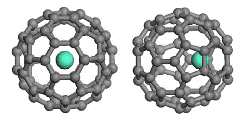Chemistry, Department of: Faculty Series

Xiao Cheng Zeng Publications
Document Type
Article
Date of this Version
3-24-2021
Citation
JACS Au 2021, 1, 475−483. https://doi.org/10.1021/jacsau.1c00014
Abstract
The intense research activities on the hybrid organic−inorganic perovskites (HOIPs) have led to the greatly improved light absorbers for solar cells with high power conversion efficiency (PCE). However, it is still challenging to find an alternative lead-free perovskite to replace the organohalide lead perovskites to achieve high PCE. This is because both previous experimental and theoretical investigations have shown that the Pb2+ cations play a dominating role in contributing the desirable frontier electronic bands of the HOIPs for light absorbing. Recent advances in the chemical synthesis of three-dimensional (3D) metal-free perovskites, by replacing Pb2+ with NH4+, have markedly enriched the family of multifunctionalized perovskites (Ye et al., Science 2018, 361, 151−155). These metal-free perovskites possess the chemical formula of A(NH4)X3, where A is divalent organic cations and X denotes halogen atoms. Without involving transitionmetal cations, the metal-free A(NH4)X3 perovskites can entail notably different frontier electronic band features from those of the organohalide lead perovskites. Indeed, the valence and conduction bands of A(NH4)X3 perovskites are mainly attributed by the halogen atoms and the divalent A2+ organic cations, respectively. Importantly, a linear relationship between the bandgaps of A(NH4)X3 perovskites and the lowest unoccupied molecular orbital energies of the A2+ cations is identified, suggesting that bandgaps can be tailored via molecular design, especially through a chemical modification of the A2+ cations. Our comprehensive computational study and molecular design predict a metal-free perovskite, namely, 6-ammonio-1-methyl-5-nitropyrimidin-1-ium- (NH4)I3, with a desirable bandgap of ∼1.74 eV and good optical absorption property, both being important requirements for photovoltaic applications. Moreover, the application of strain can further fine-tune the bandgap of this metal-free perovskite. Our proposed design principle not only offers chemical insights into the structure−property relationship of the multifunctional metal-free perovskites but also can facilitate the discovery of highly efficient alternative, lead-free perovskites for potential photovoltaic or optoelectronic applications.


Comments
Used by permission.